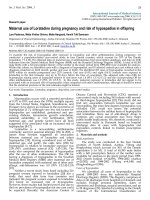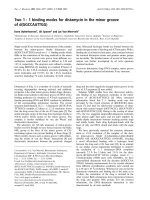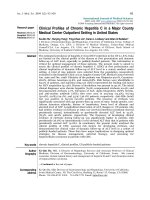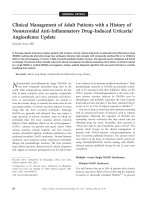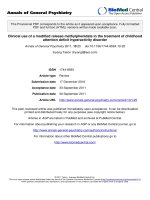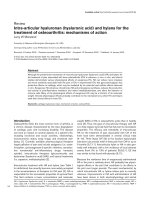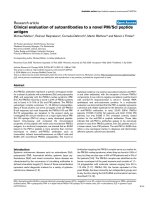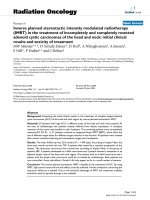Báo cáo y học: "Clinical use of a modified release methylphenidate in the treatment of childhood attention deficit hyperactivity disorder" pps
Bạn đang xem bản rút gọn của tài liệu. Xem và tải ngay bản đầy đủ của tài liệu tại đây (179.62 KB, 24 trang )
This Provisional PDF corresponds to the article as it appeared upon acceptance. Fully formatted
PDF and full text (HTML) versions will be made available soon.
Clinical use of a modified release methylphenidate in the treatment of childhood
attention deficit hyperactivity disorder
Annals of General Psychiatry 2011, 10:25 doi:10.1186/1744-859X-10-25
Inyang Takon ()
ISSN 1744-859X
Article type Review
Submission date 17 December 2010
Acceptance date 30 September 2011
Publication date 30 September 2011
Article URL />This peer-reviewed article was published immediately upon acceptance. It can be downloaded,
printed and distributed freely for any purposes (see copyright notice below).
Articles in AGP are listed in PubMed and archived at PubMed Central.
For information about publishing your research in AGP or any BioMed Central journal, go to
/>For information about other BioMed Central publications go to
/>Annals of General Psychiatry
© 2011 Takon ; licensee BioMed Central Ltd.
This is an open access article distributed under the terms of the Creative Commons Attribution License ( />which permits unrestricted use, distribution, and reproduction in any medium, provided the original work is properly cited.
Clinical use of a modified release methylphenidate in the treatment of
childhood attention deficit hyperactivity disorder
Inyang Takon*
QE II Hospital, East and North Hertfordshire NHS Trust, Welwyn Garden City, UK
*Corresponding author
Email address:
IT:
Abstract
Attention deficit hyperactivity disorder (ADHD) is the most commonly diagnosed
neurobehavioural disorder in childhood, affecting over 5% of children worldwide. As
well as the core symptoms of inattention, hyperactivity and impulsivity, patients often
exhibit learning difficulties and impairment in social functioning. The frequency of
referral is higher for boys than for girls (about 2:1), and girls are generally older at
the time of referral.
Pharmacological therapy is considered the first-line treatment for patients with
severe ADHD and severe impairment. Stimulant medications are licensed in the UK
for the management of ADHD in school-age children and young people, and are
effective in controlling ADHD symptoms.
While immediate-release preparations of methylphenidate (MPH) have proven
effective in the treatment of ADHD, there are a number of problems associated with
their use, most notably compliance, stigma and medication diversion. Modified
release preparations are now available that overcome the need for multiple daily
dosing, and which offer different MPH release profiles, thereby enabling the
physician to match the medication to the patient’s particular requirements.
This review describes the diagnosis, referral and treatment pathways for patients
with ADHD in the UK and the practical considerations when initiating
pharmacological treatment. The clinical experience of treating ADHD with a
modified-release MPH preparation (Equasym XL
®
) is illustrated with case studies.
Introduction
Attention deficit hyperactivity disorder (ADHD) is the most commonly diagnosed
neurobehavioural disorder in childhood; a recent meta-regression analysis estimated
a worldwide prevalence of 5.29% among children and adolescents [1]. It is
characterised by inappropriate levels of inattention, hyperactivity and impulsivity, and
often accompanied by comorbid symptoms such as aggressive behaviour,
depressive mood, anxiety and tics [2]. Furthermore, learning difficulties [3] and
impairment in social functioning [4] are frequently observed in patients with ADHD.
The symptoms of ADHD decline with increasing age, and although most patients
with ADHD no longer meet the full criteria for the disorder when they reach
adulthood, up to 50% of childhood cases continue to show clinically relevant
symptoms during adolescence and adult life [5].
In the UK, patients with suspected ADHD, identified through concerns from school
(teachers, special educational needs coordinators and educational psychologists) or
family members, are brought to the attention of the general practitioner (GP) via
parents. Children are then referred for further specialist assessment for ADHD. The
referral pathway varies in different parts of the country, with paediatricians carrying
out the diagnostic assessment in some areas and child psychiatrists in others; some
centres provide a joint service involving both paediatricians and child psychiatrists.
Children referred to their GP usually present with concerns of inattention,
hyperactivity and impulsivity. Symptoms impact on their academic achievements and
social interaction at school; home life can also be very difficult, as children with
ADHD are constantly active and demanding, which tends to cause conflicts with their
families. The frequency of referral is higher for boys than for girls (about 2:1), and
girls are generally older at the time of referral. This is probably because girls are
more likely to have the predominantly inattentive subtype of ADHD [6], which,
because the symptoms are less striking, is often identified only when poor academic
performance is noticed. Symptoms also vary with age and may be less obvious, but
equally impairing, in older adolescents. Notable risk factors for developing ADHD
include family history of ADHD [7], preterm birth and smoking or drinking during
pregnancy [8].
Pharmacological therapy is considered the first-line treatment for patients with
severe ADHD and severe impairment [9]. Stimulant medications, such as
methylphenidate (MPH) and dexamfetamine, and the non-stimulant, atomoxetine,
are licensed in the UK for the management of ADHD in school-age children and
young people, and are effective in controlling ADHD symptoms [9]. The guidelines
produced by the UK National Institute of Clinical Excellence (NICE) [9] recommend
MPH as the first-choice medication for patients without comorbidities, for those with
comorbid conduct disorder and when tics, Tourette’s syndrome, anxiety disorder and
stimulant misuse or risk of stimulant misuse are present; however, MPH should be
used with caution in such patients. Although the mechanism of action is not
completely understood, MPH is known to be associated with an increase in
dopamine and norepinephrine levels in the extraneuronal space, probably owing to
reuptake inhibition. This is thought to improve neurotransmission and to mediate the
beneficial effects of MPH on ADHD symptoms [10]. MPH is primarily metabolised by
de-esterification to ritalinic acid, which is pharmacologically inactive; therefore, MPH
has a low absolute bioavailability, and a short half life (2-3 h) and duration of action
[11-13].
Immediate-release formulations of MPH (MPH-IR) have been used since the 1960s
to control ADHD symptoms. With MPH-IR, peak plasma concentrations and optimum
behavioural effects are reached approximately 1.5-2.0 h after administration [14].
The limited duration of action means that most children require two or three daily
doses to maintain control of ADHD symptoms throughout the day [15]. However,
medication doses given during the school day can cause compliance issues and
problems related to privacy, stigmatisation by classmates, accountability of the
school administration and potential abuse or diversion due to availability of the
medication in school [10, 16]. To eliminate the need for multiple daily doses,
modified-release MPH (MPH-MR) formulations have been designed which combine
IR and delayed-release (DR) components, and produce a rapid onset of therapeutic
effect while having a sufficient duration to eliminate the need for additional dosing.
MR formulations avoid the oscillations in plasma concentration seen with multiple
dosing of MPH-IR, but at the same time present a biphasic profile rather than a flat
profile, preventing the development of acute tolerance [17]. MPH-MR formulations
approved in the UK are listed in Table 1. The pharmacokinetic (PK) profile over time
of these formulations is distinct, and their effect on behaviour parallels the blood
concentration of MPH. MPH-MR 50:50 (Medikinet XL
®
) and MPH-MR 30:70
(Equasym XL
®
) have been shown to be equivalent to twice-daily MPH-IR [18, 19],
while MPH-OROS (Concerta XL
®
) is equivalent to MPH-IR, three times daily,
although at a 20% higher dose [20]. Several comparative studies between MPH-MR
products have shown the relative efficacies over different periods of the day,
depending on the release profile [21-23]. Having different MPH-MR proportions with
differing release profiles allows tailoring of treatment to each patient, depending on
the desired profile of symptom control throughout the day. This review focuses on
the practical and clinical experience with the MR preparation MPH-MR 30:70 in a UK
paediatric ADHD clinic.
Practical considerations for initiating MPH treatment
At the start of treatment with any MPH formulation, careful dose titration is
necessary. IR and long-acting formulations of MPH can both be used to initiate
treatment of ADHD [24-26]. In some cases, IR preparations are slowly titrated by
weekly increments of 5-10 mg/day according to tolerability and the degree of efficacy
observed, up to a maximum daily dose of 60 mg; IR preparations are taken in
divided doses, usually at breakfast and lunch [24]. Some patients are stabilised on
MPH-IR and then switched to a corresponding dose of MPH-MR. However, it is
commonly accepted practice now in most areas of the UK to initiate ADHD therapy
directly with the lowest available dose of MPH-MR when this medication has been
chosen as the treatment of choice. The dose should be incremented slowly, every 1-
2 weeks, until an effective dose is reached. Children as young as 6 years old can
have treatment initiated with the capsule formulations of MPH-MR, as these can be
opened and the contents given in soft food [24, 26].
From a clinical perspective, the regimen that achieves satisfactory symptom control
at the lowest total daily dose and with the fewest adverse events (AEs) should be
employed. In cases where treatment effects wear off too early, patients can be given
an extra dose of MPH-IR in the late afternoon or early evening if needed [24, 26]; for
example, for doing homework or maintaining focus during after-school activities.
However, caution should be applied in children with significant appetite suppression
or sleep problems, as the additional MPH-IR may negatively affect them.
The choice between treatment options should be determined on an individual basis,
with particular consideration of the requirement for symptom control in the latter part
of the day. MPH treatment is generally well tolerated by patients and severe AEs are
rare. Increased insomnia, other sleep-related problems and reduced appetite are
common, and there is some evidence for increased levels of emotionality, social
withdrawal, nausea and stomach aches, although it is not clear which of these AEs
are related to pre-existing problems associated with ADHD prior to treatment [27].
Furthermore, treatment tolerability does not appear to be predictable on the basis of
patients’ clinical characteristics [27].
Long-term side effects of MPH include weight loss from reduced appetite and
reduction in height velocity [28]; the magnitude of such effects has been
controversial for many years [29]. The cause of the reduction in height velocity is not
entirely clear [30]. In some cases, it is thought that it may be secondary to the effect
of MPH on weight [30]. It has also been suggested that ADHD itself may be
associated with temporary deficits in height gain during mid adolescence, supporting
the hypothesis that this effect could be a consequence of the disease rather than its
treatment [31]. The height of most children normalises with increased age and most
achieve normal adult height; however, in a few cases where height is significantly
affected during ongoing monitoring, children should be referred to a paediatric
endocrinologist to rule out any undiagnosed growth problems.
Equasym XL
This MPH-MR 30:70 formulation of MPH contains a 30:70 ratio of IR to DR MPH by
weight [17]. It uses a multiparticulate bead delivery system in a capsule, in which
each bead acts as a drug reservoir; a distinct advantage of this system is that
capsules can be swallowed whole, or their contents can be sprinkled onto a small
amount of apple sauce, without altering the bioavailability of the MPH [32]. This may
be helpful in very small children or those with swallowing or gastrointestinal issues.
The efficacy of MPH-MR 30:70
in children with ADHD has been demonstrated in
three 3-week randomised, double-blind studies: a placebo-controlled non-inferiority
study compared with a twice-daily IR formulation [19] and a parallel-group, placebo-
controlled clinical trial [33], both conducted in a community setting, and a
comparative, laboratory classroom study, (Comparison Of Methylphenidates in an
Analog Classroom Setting (COMACS)) [23], with several secondary analyses [27,
34-37]. Study details are shown in Table 2.
These trials show that MPH-MR 30:70 is an effective and well tolerated once-daily
treatment for ADHD [19, 27, 33-37]. However, the COMACS secondary analyses
also made it clear that different patients respond in different ways to MPH-MR
formulations [35, 36]. This heterogeneity of response is an important consideration
when deciding treatment options for children with ADHD. COMACS also showed that
parents and teachers assess symptoms differently, highlighting the need for
comprehensive assessment measures [37]. It should also be noted that clinical trial
data represent the average values from variable populations. Therefore, for each
individual, the most rational initial choice (based on clinical trial results) might not be
the best treatment. Reliable, cost-effective, predictive factors that can be used in
everyday clinical practice are needed.
Challenges in clinical practice
In the specialist ADHD clinic in East and North Hertfordshire, UK, assessment is by
use of the P4 screening questionnaire, which is a 33-item screening questionnaire
based on the Diagnostic and Statistical Manual, fourth edition (DSM-IV) criteria and
which assesses the core symptoms of ADHD: concentration, hyperactivity and
impulsivity. The P4 was designed by one of the consultant child psychiatrists in the
team and has been in use for 15 years as one of the tools available for screening the
core symptoms of ADHD. The questionnaire has shown good correlation with
information received from school and home in identifying children with ADHD,
although it has not been validated in population studies. The diagnostic assessment
in our unit involves: (1) diagnostic interview with the parent/carer and the child/young
person in the clinic (the interview lasts on average 1 h). (2) School observation of the
primary school child to assess for core symptoms of ADHD. This observation is
usually carried out by the ADHD nurse specialist, using a structured form. The
process includes observation of the child in the playground to observe social
interaction with peers, observation of the child during lessons to check for impulsive
and inattentive behaviours as well as overactivity, and a review of the child’s
completed class work. (3) Review of the screening questionnaires (P4) sent to home
and school. Screening questionnaires are usually sent to the different subject
teachers for the secondary school child.
After the conclusion of the diagnostic assessment by the paediatrician, the child
psychiatrist, or both, a discussion is held with the parents and the young patient
about the diagnosis and the different types of management options available.
Information on where to access further parenting courses in managing the child’s
behaviour and psychoeducational materials are made available. When
pharmacological therapy is recommended, the various types of medication available
and their risks and benefits are discussed, and it is general practice to make this as
visual as possible for the child and his/her parents by showing them dummy tablets
of the proposed medication. Each of the child’s difficulties is considered, to evaluate
areas of particular concern. It is worth noting that the majority of parents accept
pharmacological treatment for their children when indicated, although it is worth
spending some time explaining how the medication works and allowing them to ask
any questions they might have. Families also have further access to the ADHD nurse
who sees the families after the initial clinic appointment and who discusses further
questions that families may have and provides information on additional resources
needed. Consent is usually obtained from the families to contact the school, and
information on managing ADHD within the school is also forwarded to the class
teacher.
In primary school children, who carry out most of their schoolwork in school with little
requirement for homework after school, preparations such as MPH-MR 30:70 are
very useful. The child feels better as all the medication is taken at home before
leaving for school and there is a lower risk of poor compliance, as parents ensure the
child takes the medication. In addition, there is a lower risk of stigmatisation in
school.
The ADHD nurse specialist is a key team member in the East and North
Hertfordshire ADHD service. This nurse will usually follow-up, by telephone, with the
family, 1-2 weeks after the medication regimen has started in order to assess the
child’s response to the medication, and to start titration to the therapeutic dose. All
follow-up visits use a structured pro forma that is used to review the core symptoms
of ADHD and side effects of medication (in children treated with medication). The
instrument also captures information on progress with learning and any emotional
concerns. A summary of discussions with the family is maintained, including an
action plan and plan for reviews.
Children started on medication are usually seen in the clinic after 1 month, and the
optimal dose is determined. They are subsequently followed up on a 6-monthly basis
if their symptoms are stable, and their height, weight and blood pressure are
monitored; this is sometimes performed by the ADHD nurse specialist in the nurse-
led clinic. Parents are instructed to contact the ADHD team (nurse specialist or
clinician) if they have any concerns that require an earlier review. Side effects are
usually transient and tend to subside. Children treated for ADHD with more complex
issues, who have poor tolerance to medication or who experience side effects are
usually seen more frequently, and follow-up varies from monthly to 3-monthly. There
is flexibility within the service to see children earlier if the need arises. The structured
pro forma described above is used during all follow-up visits, including telephone
consultations.
It is useful to have an up-to-date progress report from the school for the follow-up
visits. This helps to monitor progress on the core symptoms of ADHD and also to
find out about school, home and sibling progress. Where there is a lack of response
to the medication, it is advisable to explore possible reasons through a discussion
with the child, rather than stop treatment abruptly.
Children who are stable on the 8-h preparation of MPH-MR 30:70 can be prescribed
an additional MPH-IR dose in the evening when they make the transition to
secondary school. This prevents changing the preparation to an entirely different
one, particularly when it has been well tolerated, and extends symptom control to
allow management of homework or other after-school activities.
Managing side effects
The majority of children respond well to long-acting MPH, although a few patients
show appetite suppression and other side effects such as emotional concerns,
anxiety, mood changes and tics. In some cases, temporary withdrawal of long-acting
MPH may be necessary to see if the side effects subside.
To manage poor weight gain, children may receive additional calories in the form of
milk shakes or additional foods recommended by dieticians. With the 8-h MPH
preparation there is usually a catch-up period in the evenings, when the medication
effect wears off and children eat normally. Children are usually advised to eat a
substantial breakfast before taking their medication and most are able to eat a
healthy portion of food in the evening.
Children with reduced height velocity may need to discontinue the medication
temporarily if their height velocity continues to drop. As mentioned above, referral to
a paediatric endocrinologist will determine whether there is an underlying growth
problem.
Headaches and abdominal pain usually improve after the first week of treatment;
however, if they persist, analgesia can be given to relieve the symptoms. Emotional
lability also usually improves with time; if it persists, the dose of the medication
should be reviewed.
Illustrative case studies of patient-tailored treatment with MPH-MR 30:70
Case study 1
Patient 1, age 14 years, presented with behavioural difficulties at home and school,
and was first seen by clinicians following referral to the ADHD clinic at the age of 10
years. Concerns raised included challenging behaviour, impulsive behaviour,
hyperactivity and fidgeting. Patient 1 lashed out very easily and struggled to calm
down when he had an outburst; he had many outbursts at school, which made his
peers wary of him, and was worried about his social skills.
Patient 1 had some initial risk factors. He was born following a full-term pregnancy,
weighed 3.5 kg and was in the special care baby unit for 2 days as a result of low
blood sugar. He was the second child born to his mother. There was a history of
domestic violence from patient 1’s father, and his mother also had a history of
psychiatric illness. Patient 1 had normal motor development milestones, but his
speech and language development were delayed, and he also suffered from sleep
difficulties.
Patient 1 was diagnosed with ADHD at age 6.5 years in a different county but had
not been treated with medication. Patient 1 and his mother then relocated to a
different county and a further review of his symptoms was requested following
increasing concerns regarding his behaviour at home and at school. The
assessments consisted of a diagnostic interview by clinicians and a screening of the
information received from home and the school. It was confirmed that patient 1 had
ADHD combined type.
Patient 1 started treatment with MPH-OROS, but significant symptom control was
not achieved; his dosage was steadily titrated up to the maximum recommended
dose of MPH-OROS (72 mg) but he felt that the medication effect wore off easily and
also affected his appetite. Patient 1’s medication was subsequently changed to 50
mg/day MPH-MR 30:70, and then titrated up to 60 mg/day,
which he tolerated better
than MPH-OROS. He made significant improvements: his concentration and his
school grades improved (he also moved to a smaller school). Patient 1’s weight,
height and blood pressure were normal for his age.
Patient 1 is now making good progress in school and is generally happier, as
confirmed by school reports, parental reports of school progress and by the
medication monitoring document. He has also been able to form friendships. He is
being followed up every 6 months in the ADHD clinic.
Case study 2
Patient 2 was referred at age 5.5 years, following review in a child development
centre, for concerns relating to poor concentration, impulsive behaviour and poor
interaction in school. Patient 2’s difficulties first became apparent when she was in
preschool, where she required one-to-one support. She had problems with balance
and motor skills, and walked with her feet turned in. She also had sleep difficulties
and was very restless during sleep. At nursery, she had been functioning at an
average level. Patient 2’s behaviour had a significant impact on the whole family; she
had defiant and attention-seeking behaviours.
Patient 2 was born 1 week after her due date of birth; there were no concerns
following her birth and she had been in good health. There was a family history of
psychiatric illness in her mother’s grandfather, as well as a history of hyperactivity
and defiant behaviours in patient 2’s cousin. Patient 2’s clinical examination showed
joint laxity but her neurological examination was normal.
Patient 2 had a diagnostic assessment for ADHD and was found to have very high
scores for inattention, hyperactivity and impulsivity, leading to a diagnosis of ADHD
combined type with comorbid oppositional defiant disorder. ADHD management was
discussed with the family, and her parents’ decision was to try behavioural strategies
at home and at school, and review patient 2’s behaviour and progress in 1 year.
At 1 year later, her sleep problems had worsened; she was started on melatonin to
help with her sleep, which improved slightly, but continued to have significant ADHD
symptoms that had an impact on her learning. Patient 2 was started on MPH-MR
30:70 10 mg to help control ADHD symptoms during the school day and her dose
was gradually titrated to 30 mg once daily. Patient 2’s ADHD and comorbid
symptoms improved, including her concentration, her play and social skills, her
relationship with friends, parents and sibling, and her sleep difficulties. Her dyspraxia
and motor difficulties also improved.
Patient 2 has made good progress on MPH-MR 30:70 30 mg and has had no side
effects; she continues to have 2 mg of melatonin at night to improve her sleep
pattern. She is being followed up on a 6-month basis.
Case study 3
Patient 3, age 10 years, was referred at age 8 years with significant concerns about
her behaviour in school. She was very talkative in class, fidgety and disruptive.
Patient 3 was born following a normal pregnancy and had no problems after birth.
She was an only child and was brought up following a very strict routine. Her
developmental milestones were advanced, and she had many falls and emergency-
room visits in the first few years of life. She also struggled significantly with learning
and was found to have dyslexia. Although her dyslexia was well supported, she
struggled continuously with her concentration; she frequently got into trouble in
school and this caused significant difficulties for her parents, whose work life was
constantly disrupted by calls from the school.
Patient 3’s parents had her referred for further assessment for ADHD. The positive
and problem profile questionnaire (similar to the strengths and difficulties
questionnaire) was sent to her parents and the school, and school observation was
arranged by the ADHD nurse specialist. Patient 3 showed borderline scores for all
the core symptoms of ADHD.
Patient 3 was initially started on MPH-IR, 10 mg twice daily, following her parents’
request for a short-acting preparation, to help them monitor her response during
medication titration. The effect of the medication wore off quickly so her symptoms
were not fully controlled. Her medication was then switched to MPH-MR 30:70,
30
mg once daily, to which she responded better. Patient 3 was satisfied with the once-
daily dosage of MPH-MR 30:70 as she did not need to take medication in school and
be different from her peers. Patient 3’s relationship with her peers improved, and
although she had slight appetite suppression whilst on the medication, she was able
to have a normal evening meal with her family when she got back home, after the
medication effect wore off.
Patient 3 has made good progress on MPH-MR 30:70
and her symptoms are well
controlled during the school day. She is due to start secondary school education and
the plan is for patient 3 to continue taking MPH-MR 30:70
for the school day, with the
option to add an MPH-IR preparation for the late afternoon when she is required to
concentrate on homework. Patient 3 is satisfied with continuing the medication in
secondary school.
Case study 4
Patient 4, age 10 years, had a long history of poor concentration, and defiant and
challenging behaviour. She was born following a normal pregnancy and delivery, and
had a history of delay in all areas of her development; she walked late, talked late
(age 3) and found mainstream schooling very challenging.
Patient 4’s parents separated when she was 4 years old, and a shared contact
arrangement with both parents was agreed. After the separation of her parents,
patient 4’s behaviour became increasingly challenging. She found it difficult to settle
in mainstream school and made little progress in her learning; she was, therefore,
transferred to a special school for children with moderate learning disabilities. Patient
4’s behaviour continued to deteriorate in the special school. She was very impulsive,
defiant and constantly fidgety; she lashed out frequently at teachers and other
children, and had a very poor concentration span. She had a structured behavioural
management plan in school as well as a period of monitoring. However, although her
behaviour improved slightly, she made no progress in her learning, as reflected by
her poor school grades and her teachers’ reports, and she continued to have
problems with concentration and constant fidgeting.
Patient 4 was assessed for ADHD and her symptoms met the diagnostic criteria for
ADHD with comorbid oppositional defiant disorder. She was started on a low dose of
MPH-IR and showed a slight improvement but had significant rebound symptoms
and several emotional side effects. She was moody, very tearful and her behaviour
was of concern at home and at school. Her medication was then changed to MPH-
MR using MPH-MR 30:70. She showed a slight improvement for a few weeks at a
dose of 20 mg/day but had significant problems with poor appetite and poor sleeping
patterns; according to her parents, she was also more aggressive on MPH-MR
30:70. The dose was reduced to 10 mg without any appreciable reduction of side
effects. As she did not tolerate even small doses of MPH, MPH-MR 30:70
was
discontinued and clonidine (starting at 25 µg once daily for 1 week, titrated up to 25
µg twice daily for 1 month), a non-stimulant preparation, was started to help with
ADHD symptoms. Although clonidine is not currently approved in ADHD, evidence
suggests it may have some benefit [38]. After 1 month at 25 µg twice daily, clonidine
was also discontinued as patient 4 still showed many side effects and appeared
subdued, very moody and tearful on medication.
Patient 4 had all medication discontinued, and a period of monitoring was carried out
with more behavioural support and one-to-one management. She continued to
struggle with poor attention and concentration, showed a lack of progress with
learning and exhibited high levels of anxiety. A meeting of health, education and
social services professionals was held to address patient 4’s needs. She was
reassessed by the doctor and diagnosed with ADHD, comorbid oppositional defiant
disorder and additional comorbidities, such as anxiety symptoms and learning
difficulties. She was also assessed for autistic spectrum disorder but did not meet
the diagnostic criteria.
Patient 4 was trialled on atomoxetine and given access to a nurse support service for
patients on this medication, run by an independent provider. She was started on 10
mg once daily for 2 weeks, titrated to 18 mg once daily for 2 weeks, and then
maintained on 25 mg once daily thereafter. Titration was performed slowly, with
close monitoring. Patient 4 showed a significant response to atomoxetine: her core
ADHD symptoms improved, she was less anxious and her appetite and sleep
improved. She still has some residual symptoms of impulsivity but, overall, she has
made progress through a combination of atomoxetine and behavioural strategies.
Conclusions
The early identification of ADHD symptoms in children is essential to prevent the
complications that arise from late diagnosis. Children with risk factors for ADHD
(such as prematurity, low blood sugar, difficulties around the time of birth with
hypoxic brain injuries or infections, and children who develop difficulties with
concentration and learning) [39-41] need to be screened and assessed for ADHD.
Sleep difficulties are also common in children with ADHD [42] and may be an early
sign in some cases. Sleep problems in children who also have a diagnosis of ADHD
may improve upon treatment with medication [43].
Treatment with MPH-MR 30:70 prevents disruption in the child’s school day
programme by removing the need for a lunchtime medication dose administered in
school. Parents who have doubts about medication treatment and concerns about
the child taking medication in school are more likely to accept treatment with a
flexible once-a-day preparation such as MPH-MR 30:70.
Children treated with MPH-MR 30:70 can have problems with appetite suppression,
but as the effect wears off in the evening, the child is usually able to eat a normal
evening meal, which prevents weight loss in most children.
Some children with learning difficulties and ADHD can have a poorer response to
MPH compared with children without comorbidities. In these cases, the side effects
of MPH-MR 30:70 can be seen with very small doses of MPH. Children with poor
response to MPH-MR 30:70 and other MPH preparations should have their
symptoms re-evaluated to rule out comorbidities such as anxiety disorder and
autistic spectrum disorder, which may account for the poor response.
Providing adequate support for children treated with MPH-MR 30:70 is essential to
ensure compliance with treatment.
Consent
Formal consent has been obtained by the Author for all cases reported in the
article.
Competing interests
Support was received from Shire Pharmaceuticals Ltd to attend conferences.
Acknowledgements
The author would like to thank Alisa Woods, PhD (Shire Development, Inc.), Simon
Hatch, MD (Shire Development, Inc.) and Monica Shaw, MD (Shire Pharmaceuticals
Ltd) for constructive critical review. Writing support for portions of the manuscript,
assistance in collating the comments of the contributors and implementing revisions
was provided by Monica Guidi, PhD, and Jackie Marchington, PhD (Caudex Medical,
Oxford, UK), under the direction of IT and funded by Shire Development, Inc.
Author information
IT is the lead paediatrician for ADHD services in East Hertfordshire, UK, where she
runs a weekly joint ADHD clinic with the Child and Adolescent psychiatrist and works
within an ADHD specialist team. IT also sees children with other neurodisability
issues who may have comorbid ADHD, where the presentation may be more
complex and challenging to manage. IT has vast experience in managing children
with complex ADHD. She has 18 years of experience in paediatrics and also has
extensive experience in the use of psychopharmacologic agents in managing
children with ADHD.
References
1. Polanczyk G, de Lima MS, Horta BL, Biederman J, Rohde LA: The worldwide
prevalence of ADHD: a systematic review and metaregression analysis. Am
J Psychiatry 2007, 164:942-948.
2. Spencer T, Biederman J, Wilens T: Attention-deficit/hyperactivity disorder
and comorbidity. Pediatr Clin North Am 1999, 46:915-927, vii.
3. Cutting LE, Koth CW, Mahone EM, Denckla MB: Evidence for unexpected
weaknesses in learning in children with attention-deficit/hyperactivity
disorder without reading disabilities. J Learn Disabil 2003, 36:259-269.
4. DuPaul GJ, McGoey KE, Eckert TL, VanBrakle J: Preschool children with
attention-deficit/hyperactivity disorder: impairments in behavioral, social,
and school functioning. J Am Acad Child Adolesc Psychiatry 2001, 40:508-
515.
5. Biederman J, Faraone SV: Attention-deficit hyperactivity disorder. Lancet
2005, 366:237-248.
6. Biederman J, Mick E, Faraone SV, Braaten E, Doyle A, Spencer T, Wilens TE,
Frazier E, Johnson MA: Influence of gender on attention deficit hyperactivity
disorder in children referred to a psychiatric clinic. Am J Psychiatry 2002,
159:36-42.
7. Faraone SV, Khan SA: Candidate gene studies of attention-
deficit/hyperactivity disorder. J Clin Psychiatry 2006, 67(Suppl 8):13-20.
8. Banerjee TD, Middleton F, Faraone SV: Environmental risk factors for
attention-deficit hyperactivity disorder. Acta Paediatr 2007, 96:1269-1274.
9. NICE: Diagnosis and Management of ADHD in Children, Young People and
Adults. National Clinical Practice Guideline Number 72 edition. London, UK: The
British Psychological Society/The Royal College of Psychiatrists; 2009.
10. Greenhill LL, Halperin JM, Abikoff H: Stimulant medications. J Am Acad Child
Adolesc Psychiatry 1999, 38:503-512.
11. Chan YP, Swanson JM, Soldin SS, Thiessen JJ, Macleod SM, Logan W:
Methylphenidate hydrochloride given with or before breakfast: II. Effects
on plasma concentration of methylphenidate and ritalinic acid. Pediatrics
1983, 72:56-59.
12. Pelham WE, Greenslade KE, Vodde-Hamilton M, Murphy DA, Greenstein JJ,
Gnagy EM, Guthrie KJ, Hoover MD, Dahl RE: Relative efficacy of long-acting
stimulants on children with attention deficit-hyperactivity disorder: a
comparison of standard methylphenidate, sustained-release
methylphenidate, sustained-release dextroamphetamine, and pemoline.
Pediatrics 1990, 86:226-237.
13. Swanson J, Kinsbourne M, Roberts W, Zucker K: Time-response analysis of
the effect of stimulant medication on the learning ability of children
referred for hyperactivity. Pediatrics 1978, 61:21-29.
14. Patrick KS, Straughn AB, Jarvi EJ, Breese GR, Meyer MC: The absorption of
sustained-release methylphenidate formulations compared to an
immediate-release formulation. Biopharm Drug Dispos 1989, 10:165-171.
15. Elia J, Ambrosini PJ, Rapoport JL: Treatment of attention-deficit-hyperactivity
disorder. N Engl J Med 1999, 340:780-788.
16. Horrigan JP, Kohli RR: The impact of dosing frequency on psychostimulant
compliance in ADHD. NIMH - 42nd Annual NCDEU Meeting 2002, Poster 56.
Boca Raton, FL; June 10-13.
17. Wigal SB, Sanchez DY, DeCory HH, D'Imperio JM, Swanson JM: Selection of
the optimal dose ratio for a controlled-delivery formulation of
methylphenidate. J Appl Res 2003, 3:46-63.
18. Dopfner M, Gerber WD, Banaschewski T, Breuer D, Freisleder FJ, Gerber-von
MG, Gunter M, Hassler F, Ose C, Rothenberger A, Schmeck K, Sinzig J, Stadler
C, Uebel H, Lehmkuhl G: Comparative efficacy of once-a-day extended-
release methylphenidate, two-times-daily immediate-release
methylphenidate, and placebo in a laboratory school setting. Eur Child
Adolesc Psychiatry 2004, 13(Suppl 1):I93-101.
19. Findling RL, Quinn D, Hatch SJ, Cameron SJ, DeCory HH, McDowell M:
Comparison of the clinical efficacy of twice-daily Ritalin and once-daily
Equasym XL with placebo in children with attention deficit/hyperactivity
disorder. Eur Child Adolesc Psychiatry 2006, 15:450-459.
20. Pelham WE, Gnagy EM, Burrows-Maclean L, Williams A, Fabiano GA, Morrisey
SM, Chronis AM, Forehand GL, Nguyen CA, Hoffman MT, Lock TM, Fielbelkorn
K, Coles EK, Panahon CJ, Steiner RL, Meichenbaum DL, Onyango AN, Morse
GD: Once-a-day Concerta methylphenidate versus three-times-daily
methylphenidate in laboratory and natural settings. Pediatrics 2001,
107:E105.
21. Lopez F, Silva R, Pestreich L, Muniz R: Comparative efficacy of two once
daily methylphenidate formulations (Ritalin LA and Concerta) and placebo
in children with attention deficit hyperactivity disorder across the school
day. Paediatr Drugs 2003, 5:545-555.
22. Silva R, Muniz R, Pestreich LK, Brams M, Childress A, Lopez FA: Efficacy of
two long-acting methylphenidate formulations in children with attention-
deficit/hyperactivity disorder in a laboratory classroom setting. J Child
Adolesc Psychopharmacol 2005, 15:637-654.
23. Swanson JM, Wigal SB, Wigal T, Sonuga-Barke E, Greenhill LL, Biederman J,
Kollins S, Nguyen AS, DeCory HH, Hirshe Dirksen SJ, Hatch SJ: A comparison
of once-daily extended-release methylphenidate formulations in children
with attention-deficit/hyperactivity disorder in the laboratory school (the
Comacs Study). Pediatrics 2004, 113:e206-e216.
24. Equasym XL SPC (UK): Equasym XL SPC (UK).
[ />2c+20+mg+or+30+mg+Capsules/]
25. Concerta XL SPC (UK): Concerta XL 18 mg - 36 mg prolonged release
tablets SPC (UK). [
XL 18 mg - 36 mg prolonged release tablets/]
26. Medikinet XL SPC (UK): Medikinet XL SPC (UK).
[ XL/]
27. Sonuga-Barke EJ, Coghill D, Wigal T, DeBacker M, Swanson J: Adverse
reactions to methylphenidate treatment for attention-deficit/hyperactivity
disorder: structure and associations with clinical characteristics and
symptom control. J Child Adolesc Psychopharmacol 2009, 19:683-690.
28. Faraone SV, Biederman J, Morley CP, Spencer TJ: Effect of stimulants on
height and weight: a review of the literature. J Am Acad Child Adolesc
Psychiatry 2008, 47:994-1009.
29. Meijer WM, Faber A, van den BE, Tobi H: Current issues around the
pharmacotherapy of ADHD in children and adults. Pharm World Sci 2009,
31:509-516.
30. Poulton A: Growth on stimulant medication; clarifying the confusion: a
review. Arch Dis Child 2005, 90:801-806.
31. Spencer T, Biederman J, Wilens T: Growth deficits in children with attention
deficit hyperactivity disorder. Pediatrics 1998, 102:501-506.
32. Pentikis HS, Simmons RD, Benedict MF, Hatch SJ: Methylphenidate
bioavailability in adults when an extended-release multiparticulate
formulation is administered sprinkled on food or as an intact capsule. J Am
Acad Child Adolesc Psychiatry 2002, 41:443-449.
33. Greenhill LL, Findling RL, Swanson JM: A double-blind, placebo-controlled
study of modified-release methylphenidate in children with attention-
deficit/hyperactivity disorder. Pediatrics 2002, 109:E39.
34. Sonuga-Barke EJ, Swanson JM, Coghill D, DeCory HH, Hatch SJ: Efficacy of
two once-daily methylphenidate formulations compared across dose levels
at different times of the day: preliminary indications from a secondary
analysis of the COMACS study data. BMC Psychiatry 2004, 4:28.
35. Sonuga-Barke EJ, Coghill D, Markowitz JS, Swanson JM, Vandenberghe M,
Hatch SJ: Sex differences in the response of children with ADHD to once-
daily formulations of methylphenidate. J Am Acad Child Adolesc Psychiatry
2007, 46:701-710.
36. Sonuga-Barke EJ, Van LP, Swanson JM, Coghill D, Wigal S, Vandenberghe M,
Hatch S: Heterogeneity in the pharmacodynamics of two long-acting
methylphenidate formulations for children with attention
deficit/hyperactivity disorder. A growth mixture modelling analysis. Eur
Child Adolesc Psychiatry 2008, 17:245-254.
37. Sonuga-Barke EJ, Coghill D, DeBacker M, Swanson J: Measuring
methylphenidate response in attention-deficit/hyperactvity disorder: how
are laboratory classroom-based measures related to parent ratings? J Child
Adolesc Psychopharmacol 2009, 19:691-698.
38. Palumbo DR, Sallee FR, Pelham WE Jr, Bukstein OG, Daviss WB, McDermott
MP: Clonidine for attention-deficit/hyperactivity disorder: I. Efficacy and
tolerability outcomes. J Am Acad Child Adolesc Psychiatry 2008, 47:180-188.
39. Saigal S: Follow-up of very low birthweight babies to adolescence. Semin
Neonatol 2000, 5:107-118.
40. Seubert DE, Stetzer BP, Wolfe HM, Treadwell MC: Delivery of the marginally
preterm infant: what are the minor morbidities? Am J Obstet Gynecol 1999,
181:1087-1091.
41. Stenninger E, Flink R, Eriksson B, Sahlen C: Long-term neurological
dysfunction and neonatal hypoglycaemia after diabetic pregnancy. Arch Dis
Child Fetal Neonatal Ed 1998, 79:F174-F179.
42. Konofal E, Lecendreux M, Cortese S: Sleep and ADHD. Sleep Med 2010,
11:652-658.
43. Kim HW, Yoon IY, Cho SC, Kim BN, Chung S, Lee H, Kim CW, Park SK, Yoo
HJ: The effect of OROS methylphenidate on the sleep of children with
attention-deficit/hyperactivity disorder. Int Clin Psychopharmacol 2010,
25:107-115.
Tables
Table 1. Extended-release preparations of methylphenidate currently available
in the UK
Brand name UK marketing company Technology IR:DR ratio
Medikinet XL Flynn Pharma Ltd Multiparticulate bead system 50:50
Equasym XL Shire Pharmaceuticals Ltd Multiparticulate bead system 30:70
Concerta XL Janssen-Cilag Ltd Osmotic release oral system 22:78
DR = delayed release; IR = immediate release.
Table 2. Clinical studies assessing the efficacy of MPH-MR 30:70
Parameter Information
Study
Greenhill et al., 2002 [33]
Type Community setting. Multicentre, placebo-
controlled, USA.
Population characteristics 6-16 years old, mild ADHD
Interventions Placebo (163), MPH-MR 30:70 (158)
Dose and duration 20-60 mg/day, titrated to optimum
efficacy (3 weeks)
Outcome measures Teacher and Parent Conners’ Global
Index, CGI-S, CGI-I
Conclusions Equasym XL administered once daily in
the morning was well tolerated and
significantly more effective than placebo
in controlling ADHD symptoms
throughout the school day. Symptom
control was achieved in the morning and
afternoon.
Study
Findling et al., 2006 [19]
Type Community setting. Non-inferiority,
Australia, Canada and USA.
Population characteristics 6-12 years old, ADHD
Interventions Placebo, Ritalin (IR), MPH-MR 30:70
Dose and duration According to prestudy MPH regimen.
Equasym XL, 20-60 mg/day; Ritalin, 10-
30 mg twice daily (3 weeks).
Outcome measures Teacher’s and parent’s IOWA Conners’
Rating Scale
Conclusions Equasym XL once daily was statistically
non-inferior to Ritalin twice daily in the
treatment of school-age children with
methylphenidate-responsive ADHD. Both
Equasym XL and Ritalin were superior to
placebo in controlling ADHD symptoms,
and were well tolerated.
Study
Swanson et al., 2004 [23]
Type Laboratory-classroom setting. Double-
blind, three-way, crossover study, USA.
Population characteristics 6-12 years old, confirmed ADHD
Interventions MPH-MR 30:70, Concerta
XL
Dose and duration Assigned to low (20 or 18 mg/day),
medium (40 or 36 mg/day) or high (60 or
54 mg/day) dose according to prestudy
MPH dose. Crossover design, so all
patients received both active agents and
placebo for 7 days each throughout a 3-
week period.
Outcome measures SKAMP Rating Scale, PERMP
Conclusions There were statistically significant
differences between the efficacy of
Equasym XL and Concerta in children
with ADHD in the laboratory school
setting. As predicted by the PK/PD
model, clinical superiority at any time
point was achieved by the formulation
with the highest expected plasma
methylphenidate concentration.
ADHD = attention deficit hyperactivity disorder; CGI-I = Clinical Global Impression -
Improvement; CGI-S = Clinical Global Impression - Severity; IOWA =
inattention/overactivity with aggression; IR = immediate release; PERMP =
Permanent Product Measure of Performance; SKAMP = Swanson, Kotkin, Agler, M-
Flynn and Pelham.

